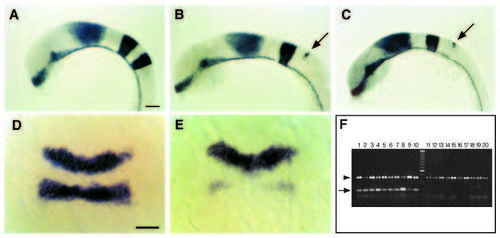
krox20 expression is disrupted in val- embryos early during hindbrain development. We screened 472 ENUmutagenized and 741 g- ray-mutagenized haploid genomes, and identified three alleles of valentino, one ENU-induced (valb337) and two g-rayinduced (valb361 and valb475). (A-C) Whole-mount RNA in situ hybridizations in lateral view showing expression of three genes, shh, en3 and krox20, in 18 h wild-type (A), valb337 (B) and valb361 (C) embryos. Anterior is to the left. In both alleles of valentino shown here, the r5 stripe of krox20 staining is reduced to a vestigial strip of expression in the dorsal hindbrain at the position of the r4-r5 boundary (arrow). (D,E) Dorsal views of whole-mount RNA in situs showing expression of krox20 in wild-type (D) and valb337 (E) embryos at the 2- to 3-somite stage (10J- 11 h). Anterior is to the top. In val- embryos, krox20 expression is already disrupted in the presumptive r5. (F) Following RNA in situ hybridization at the 2- to 3-somite stage, embryos from a cross between valb361/val+ individuals were sorted based on krox20 expression and then their genotype was determined by PCR using snail2, which is deleted in valb361 (see Materials and Methods). 10/10 individuals scored as wild-type were in fact wild type as determined by PCR (lanes 1-10) and 10/10 individuals scored as mutant were in fact mutant (lanes 11-20). Arrow: snail-2; arrowhead: nk2.2, an unlinked gene that is amplified from both wild-type and mutant DNA. Scale bars, 50 μm.
|

